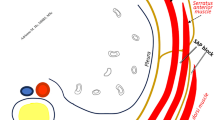Abstract
Introduction
Sternal fractures are debilitating due to intractable pain, constant fracture movement and limited range of motion (ROM) of the upper extremities (UE). Traditional treatment comprises mainly of pain control, delaying return to daily activities. Recently, sternal fixation has gained popularity. There is, however, a lack of literature demonstrating efficacy. We report our experience of traumatically fractured sternal fixation.
Methods
Following IRB approval, a retrospective chart review was completed for all patients undergoing sternal fixation by a single trauma surgeon at our Level I trauma center. Basic demographics were obtained. Primary outcomes included average cumulative pain scores, total cumulative narcotic amounts and total number of pain medication agents utilized prior to and after sternal fixation. Secondary outcome included physical therapy UE ROM before and after surgery. Paired t tests were used for comparison; significance set at p < 0.05.
Results
Thirteen patients underwent sternal fixation from 8/2016 to 2/2018. Average age was 54.4 ± 20.8 years; 54% were female. All patients experienced blunt trauma; average injury severity score was 15.8 ± 10.9 and abbreviated chest injury score was 2.5 ± 0.51. Average intensive care unit/hospital length of stay was 2.3/10.2 days. Average pain scores significantly improved by a score of 3.5 postoperatively (preoperative = 7.08 ± 2.3, postoperative = 3.54 ± 2.5; p = 0.001). Total pain medications required by sternal fixation patients significantly decreased by 1 medication postoperatively (preoperative = 4.2 medications, postoperative = 3.2 medications; p = 0.002). Average narcotic requirements significantly decreased by 7.59 morphine milligram milliequivalents (MME) after sternal fixation (preoperative amount = 71.78 MME, postoperative amount = 64.19 MME; p = 0.041). Every patient had limited UE ROM preoperatively; however, all but one patient resumed full UE ROM postoperatively (p < 0.001). There were no postoperative complications.
Conclusions
Sternal fixation is a safe and effective procedure resulting in improved pain, decreased narcotic requirements, and faster recovery.

Similar content being viewed by others
References
Klei DS, de Jong MB, Öner FC, et al. Current treatment and outcomes of traumatic sternal fractures—a systematic review. Int Orthop. 2018. https://doi.org/10.1007/s00264-018-3945-4.
Zhao Y, Yang Y, Gao Z, et al. Treatment of traumatic sternal fractures with titanium plate internal fixation: a retrospective study. J Cardiothorac Surg. 2017;12:22.
Byun CS, Park IH, Hwang WJ, et al. Analysis of sternal fixation results according to plate type in sternal fracture. Korean J Thorac Cardiovasc Surg. 2016;49:361–5.
Divisi D, Crisci R. Use of demineralized bone matrix and plate for sternal stabilization after traumatic dislocation. Gen Thorac Cardiovasc Surg. 2011;59:52–6.
Schulz-Drost S, Oppel P, Grupp S, et al. The oblique fracture of the manubrium sterni caused by a seatbelt—a rare injury? Treatment options based on the experiences gained in a level I trauma centre. Int Orthop. 2016;40:791–8.
Krinner S, Grupp S, Oppel P, et al. Do low profile implants provide reliable stability in fixing the sternal fractures as a ‘forth vertebral column’ in sternovertebral injuries? J Thorac Dis. 2017;9:1054–64.
Athanassiadi K, Gerazounis M, Moustardas M, Metaxas E. Sternal fractures: retrospective analysis of 100 cases. World J Surg. 2002;26:1243–6.
Harston A, Roberts C. Fixation of sternal fractures: a systematic review. J Trauma. 2011;71:1875–9.
Scheyerer MJ, Zimmermann SM, Bouaicha S, et al. Location of sternal fractures as a possible marker for associated injuries. Emerg Med Int. 2013;2013:407589.
Knobloch K, Wagner S, Haasper C, et al. Sternal fractures occur most often in old cars to seat-belt drivers without any airbag often with concomitant spinal injuries: clinical findings and technical collision variables among 42,055 crash victims. Ann Thorac Surg. 2006;82:444–50.
Kälicke T, Frangen TM, Müller EJ, et al. Traumatic manubriosternal dislocation. Arch Orthop Trauma Surg. 2006;126:411–6.
Ahmad K, Katballe N, Pilegaard H. Fixation of sternal fracture using absorbable plating system, three years follow-up. J Thorac Dis. 2015;7:E131–4.
Ciriaco P, Casiraghi M, Negri G, et al. Early surgical repair of isolated traumatic sternal fractures using cervical plate system. J Trauma. 2009;66:462–4.
Thomas KP, Sainudeen S, Jose S, et al. Ultrasound-guided parasternal block allows optimal pain relief and ventilation improvement after sternal fracture. Pain Ther. 2016;5:115–22.
Appelboam A, McLauchlan CAJ, Murdoch J, MacIntyre PA. Delivery of local anesthetic via a sternal catheter to reduce the pain caused by sternal fractures: first case series using the new technique. Emerg Med J. 2006;23:791–3.
Schulz-Drost S, Oppel P, Grupp S, et al. Surgical fixation of sternal fractures: preoperative planning and a safe surgical technique using locked titanium plates and depth limited drilling. J Vis Exp. 2015;95:e52124.
Nazerali RS, Hinchcliff K, Wong MS. Rigid fixation for the prevention and treatment of sternal complications. Ann Plast Surg. 2014;72:S27–30.
Kim J, Parish AL. Polypharmacy and medication management in older adults. Nurs Clin North Am. 2017;52:457–68.
Witt CE, Bulger EM. Comprehensive approach to the management of the patient with multiple rib fractures: a review and introduction of a bundled rib fracture management protocol. Trauma Surg Acute Care Open. 2017;2:e000064. https://doi.org/10.1136/tasco-2016-000064.
Volkow ND, McLellan AT. Mitigation strategies for opioid abuse. N Engl J Med. 2016;375:96.
Author information
Authors and Affiliations
Contributions
All authors contributed substantially to this research project. All authors were fully involved in this research project and collectively designed, conducted and interpreted the data. Furthermore, all authors reviewed and approved the decision to submit this manuscript for publication in its current form. The institution providing the patient population and data collected was the University of Nebraska Medical Center, Omaha, NE.
Corresponding author
Ethics declarations
Conflict of interest
There are no conflicts of interest or financial interests to disclose for any of the contributing authors.
Ethical approval
Dr. Zachary Bauman is an educational consultant for Zimmer-Biomet and KLS-Martin. This study was approved by the appropriate ethics committee at our institution and all ethical standards were followed.
Rights and permissions
About this article
Cite this article
Bauman, Z.M., Yanala, U., Waibel, B.H. et al. Sternal fixation for isolated traumatic sternal fractures improves pain and upper extremity range of motion. Eur J Trauma Emerg Surg 48, 225–230 (2022). https://doi.org/10.1007/s00068-020-01568-x
Received:
Accepted:
Published:
Issue Date:
DOI: https://doi.org/10.1007/s00068-020-01568-x




